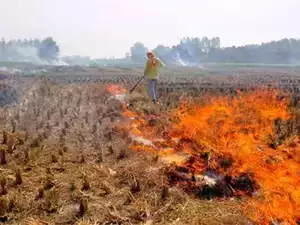Stubble Burning: Causes and Prevention
Stubble burning refers to deliberate act of setting the straw stubble that remains after rice, wheat and other grains have been harvested on fire. The stubble burning in the regions of Punjab and Haryana was one of the main reasons for the high levels of pollution in Delhi. The environmental impacts of the stubble burning is contributing to the pollution levels and is choking the Indian cities like Delhi which now has a tag of one of the worst polluted cities of the world.
How Green Revolution made the stubble burning inevitable
- The regions of northern India are producing two crops on a large scale: rice and wheat, with wheat being sown and harvested in the dry winter season, and rice to coincide with the monsoon season.
- The state governments of Punjab and Haryana have mandated that the timing of the rice planting should coincide with the monsoon rains which arrive in the region starting early July. Punjab even has a law which prohibits the cultivation of paddy before a date is decided by the government.
- Hence the two cropping periods of Kharif and Rabi for rice and wheat respectively have moved close to one another. This leaves about fifteen days in between the two crop cycles. This short span puts pressure on the farming community to prepare the farm for the next crop in a handful of days.
- Burning the residue has become a cheapest and quickest way to prepare the farm for next crop cycle because the HYV rice resulted in the residue which was much taller than the basmati residue and at the same time being less palatable as fodder for animals.
- Large scale mechanisation promoted by green revolution has also resulted in a condition which makes crop residue management harder. As the crops are cut, threshed and cleaned for grains using rotating blades, wheels, sieves and elevators, it leaves behind of the plant residues, which are about one foot tall.
- This has made stubble burning an easy and cheap option to get rid of the residues.
NGT observations on the issue of stubble burning:
- State governments had failed to curb stubble burning.
- The problem is not fully tackled and the adverse impacts on the air quality and consequent impacts on the citizens’ health and lives are undisputed.
- The NGT has directed the Chief Secretaries of Delhi, Punjab, Haryana and Uttar Pradesh to draw up a plan to provide economic incentives and disincentives to farmers.
- The issue needs to be resolved by taking all such measures which are possible in the interest of public health and environment protection.
- Incentives could be provided to those who are not burning the stubble and disincentives for those who continue the practice.
- The States concerned can wholly or partly deny the benefit of MSP to those who continue to burn the crop residue.
- Union Ministry of Agriculture and Farmers’ Welfare has also been directed to be present to find a lasting solution to the challenge of stubble burning.
How a Farmer in Punjab is leading the fight against stubble burning:
Punjab farmer Gurbachan along with his brother Gurdev has almost stopped the stubble burning two decades ago. This was long before the government has recognised stubble burning as a menace. These farmers narrate the benefits of the not burning the stubble as below:
- The alternative strategies to stubble burning have resulted in increasing the soil quality and reducing the burden of pesticide and insecticide.
- Farming without crop burning each year phases out urea fertilizer by half a bag out of the three bags of urea per acre are used on fields set on fire before sowing.
- The average organic matter in Gurbachans field and other fields where no stubble burning was done for 4-5 years was 0.8 per cent. This translates into a very high fertility rate.
A farmer understands a farmer better. Gurbachan is now the poster boy for the Krishi Vigyan Kendra’s anti-stubble burning campaign. When one among them addresses them on benefits of avoiding stubble burning it is bound to have a strong impact.The journey of this Punjab farmer was so impactful that PM Modi showered praise on this farmer during the monthly Mann Ki Baat programme.
Commercialising Stubble
Paddy is grown in about 10.5 million acres of area in Punjab and Haryana. The cost for clearing the field without burning would be at least Rs 3,000 crore per year. Hence devising a way for economical use of straw would be vital in eliminating stubble burning. Stubble can be used as a raw material to make bio-char or cellulosic ethanol or can be burnt in a power plant.
An important point which must be noted here is, for stubble to put into economical use, there is a need to remove it from the field. There can also be an alternative with no tillage cropping. Studies have shown that there would be an increase in wheat yield or at least no reduction in wheat yield with no tillage planting. A straw management system which spreads residue evenly over the field and Happy Seeder equipment which can be used for no tillage planting of wheat can aid farmers in this regard.


